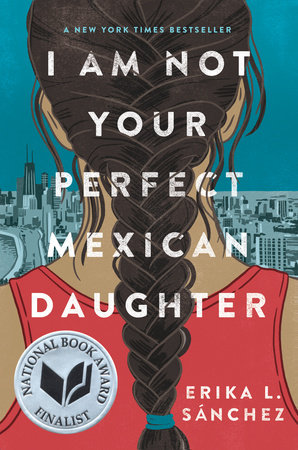
But! Every so often come books so skillful the format disappears and I get sucked completely into the story. Angie Thomas’s The Hate U Give (HarperCollins/Balzer + Bray) was one of those stunners, and Erika L. Sánchez’s I Am Not Your Perfect Mexican Daughter (Knopf, Oct.) is another.
I remember Bruce Coville once talking about J.K. Rowling’s success. I think Prisoner of Azkaban had just come out, and Mr. Coville was having a conversation with a group of Vermont College students. Like all professional children’s book writers at the time, he was sort of ruefully in awe of the way her books had captured the global imagination. It was a topic of conversation around campus, and we were all trying to figure out—on a craft level—what made these books so wildly appealing. I remember Bruce Coville—whose books have been no stranger to wild popularity themselves — saying, “Her cool-things-per-page ratio is phenomenal.”
And although I Am Not Your Perfect Mexican Daughter shares just about nothing with Harry Potter, it does share a richness-on-the-page quality. There’s so much packed into each page, so much personality in the descriptions of characters and spaces, that your mind is sparked with constant delights even when the story is in a sad spot.
The book doesn’t pull punches, and it doesn’t pretend it’s not going in deep and honest. Here’s the first sentence: “What’s surprised me most about seeing my sister dead is the lingering smirk on her face.” It’s a shocker of a sentence, and does a beautiful job setting up the promise of this book: the narrator is going to be fearlessly honest and direct, and we’d best know that’s where we’re going with her. Despite the theme of the searing loss of a family member, this novel is just so real, so funny and awful and sad and messy and wonderful—the way life is after the loss of a very close family member. The details may vary from family to family, but the crazy mix of emotions and grief and horrible decisions saved only by the grace of laughter, forgiveness, love, and compassion are universal.
I started reading almost reluctantly, because let’s face it, there are a lot of dead family members in YA literature, and there’s enough loss in real life to make me really, really not want to subject myself to it in fiction. But this book was worth diving into.
I loved the writing. The narrator notices all of the things we actually do notice in real life, but most of us don’t take the time to articulate. “Tío’s house always smells like old fruit and wet dog,” or “Lorena’s mom’s eye shadow is heavy, and her eyeliner curls up from the corners of her eyes. She kind of looks like a homely Cleopatra. Most of the time, she wears skintight spandex dresses that make her body resemble a soft-serve ice cream cone.” And, “I don’t even know what to say to that. Something about it makes me feel like all my insides are being vandalized.”
And not all of her observations are critical:
I love art almost as much as I love books. It’s hard to explain the way I feel when I see a beautiful painting. It’s a combination of scared, happy, excited, and sad all at once, like a soft light that glows in my chest and stomach for a few seconds. […] I had a similar feeling when I read an Emily Dickinson poem. I was so excited, I threw my book across the room. It was so good that it made me angry.
I’ve felt that way about unbearably beautiful things, and I’ll bet anyone reading a blog dedicated to books has, too. I don’t know if you’ll throw I Am Not Your Perfect Mexican Daughter across the room, but I guarantee it will find a host of ardent readers.

Will put this on my TBR list. Thank you!